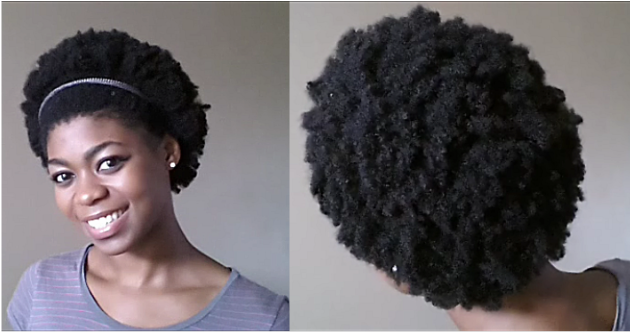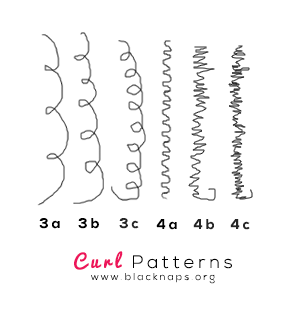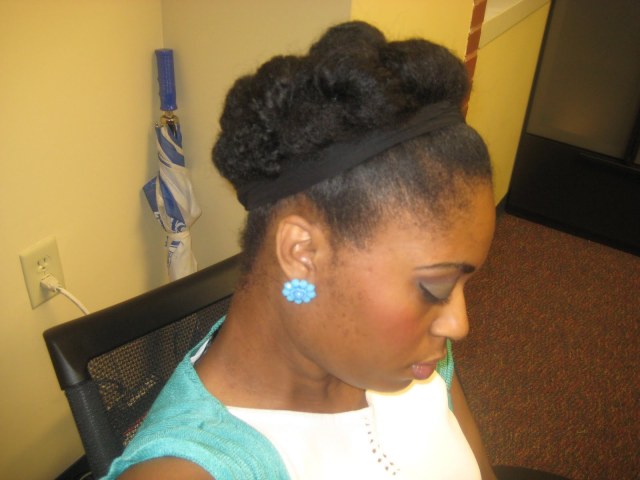I was at a restaurant when a young man approached me smiling and told me, “I love your hair? How long have you had it?”
He was referring to my dreadlocks.
That conversation doesn’t happen often with regards to my hair. People never told me they loved my hair. My hair is hard to love. But I have started loving it and the results are showing.
See the head above? It sparks different emotions in people. Awe, disgust, inspiration, fascination, hate.
For me, I am fascinated. If I met her at a quiet place, I would likely ask to touch her hair. Natural hair often stirs that urge – to run your hand through someone else’s hair.
But what stands out most for me is that that hair looks loved and well cared for, worn in pride. That’s the secret to having amazing hair, natural, synthetic or chemically altered. Love your mop, care for it and wear it with pride.
There is no good hair. There is only well-cared for hair. Though some hair is easier to care for than others.
When you love your hair you begin a journey of discovering what works for it and what doesn’t. You stop fighting your hair and trying to change it and start working with it rather than against it.
You start asking people what products they are using for their hair. You start researching stylists. You look for people who feel the same way about your hair as you do yourself. You want your stylist to get you — where you are coming from and going and to help you in that journey, not derail you.
I have to give it to the sistas in 2016 — more people are embracing their natural hair. I attended a retreat last Saturday where the median age of attendees was around 23. In a group of around 50, I could count the heads in weaves or with relaxed hair on my two hands. Braids, dreadlocks and open natural hair took the day.
People seem to have decided to try and work with their hair rather than against it, embracing curls and coils and shrinkage and denseness. They are experimenting with styles and products and hoping they’ll find that magical hair formula that makes them do a whoop and shout, “Thank you God for this hair you gave me.”
Consulting with strangers
Two Sundays ago I overheard two ladies in a church washroom discuss hair products. They both had awe-inspiring fros that looked close to this:
“How is shea butter working for you?” One asked.
“It’s only my first week, but so far so good.” The other replied replied.
Only people with natural hair can have such an easy conversation in a public washroom.
If I wasn’t in a hurry, I would have stopped to chat with them too to find out how they got those amazing curls on African 4C hair or where I can get whipped Ugandan Shea butter.
We’ve lived with the assumption that neat and professional hair is straight and well coiffed, not a strand out of place.
But then you hair type checks in and not even the hot comb can get it to style up.
Options: You either cut it, keep it permanently under heat or straighten it with chemicals. unfortunately, black hair is fragile thus relaxers leave your hair hair delicate and prone to damage. You have to work extra hard to care for it and are unlikely to achieve that long hair you wish for.
Then I go online and discover all these African women with gorgeous natural manes, some soft, others kinky, but all of it gorgeous.How does they do that? How come I am stuck out here with dry coarse hair and Venus hairfood while the rest of the girls look like pop stars out of a magazine cover?
For the longest in my life, I did not know what to do with my hair. Mine was that head that stands out in all the wrong ways, with a permanent “bench” right after the crown of my head (I guess my two hair types never planned to mix).
I also didn’t see a lot of people who were doing great stuff with their hair to inspire me or even give me ideas. Everywhere I turned I either found dull lifeless dirty product-clogged hair, or over relaxed hair that was fighting for dear life.
But honestly, how come no one ever taught us how to take care of natural hair? We were told you do not wash your hair because it will shrink and become tangled; you oil it with petroleum jellies (who remembers blue Runi and avocado oil?); you straighten it with a hot comb, sleep in matutas and wear a hard scarf to bed. Is it surprising that so many of us gave up and went the relaxer way? That regimen will only work for the select few, and still leave their hair looking unimaginative.
For lots of people, natural hair stirs negative emotions. Many of us remember classmates or teachers making snide remarks about our “shaggy” hair while growing up. Shaggy hair was a sign of untidiness, rebellion.
Not all hairs were made for the comb
A few years back, unless I had a fresh perm (which again was hard to achieve), everyone (well, almost) thought my hair to be a misfortune. You see, it is those thick, kinky, extremely thirsty types that cover the entire head and then some more, whose manageability is made worse by a sensitive scalp. Add the fact that I did not know what to do with it or which products to use, and that society then did not much appreciate natural hair, and you can understand why I would be insecure about my hair. Now I am realising: I have good hair. It’s thick, it doesn’t shed easily, it’s black and it grows. A bit dense for most combs but may be not all hairs were made to be combed.
Someone tells me when it comes to Kenyan hair, think porosity, elasticity, texture and density.
I’m still insecure about my hair, every time I am at the salon and the stylist jokes about charging me double for using more product or taking up more time than the average head; or when someone touches my locks and they are mesmerised by how “hard” they are.
Hair types
My learning curve has involved finding out about hair types. Someone woke up one day and decided that hairs need to be named. Most people I know have type 4 hair, the kinky very tightly curled hair. Type 4 hair 4 hair can range from thin to coarse, with lots of strands densely packed together
It also has fewer cuticle layers than any other hair type, which means that it has less natural protection from the damage you inflict by combing, brushing, curling, blow-drying and straightening it.
Type 4 hair falls into three categories:
The best way to see your true curl pattern is after you have washed your hair and it has aired dried without product in it.
It’s normal to have more than one hair texture. Your edges may be 4b while the majority of your hair is 4c type.
Hair care
I am also learning that type 4 hair loves creams, butters and oils and lots of water and since it is the most fragile, should be handled with lots of TLC that involves detangling with lots of conditioner, air drying it, not combing it when dry and sleeping with a satin scarf/pillow to avoid loss of moisture.
And while there are styles that are a bit complicated to whip up, just look at this video and get instant inspiration to be more adventurous.
If you are just willing to be a little adventurous, and to talk to strangers whose hair you love, you could discover the magic creams, butters, conditioners and oils that will make that 4Z hair of yours smile. I know some people would (almost) kill for my thick hair that probably pops out ten hairs from one follicle:-) Really.
Of course, going natural could be a craze or fad that you will soon outgrow as move to the next fad. However, for many other people, it’s the lifestyle choice or a destination they arrive at after trying out everything else and feeling frustrated and unsatisfied. They decide to simplify; to start afresh.
And why? Natural hair has that “look” and the authenticity behind it. I feel the freedom craved for. I feel the dedication it often calls for. I feel the courage.
Most people are afraid of keeping their hair natural claiming it is hard to maintain (it can be when you are using wrong products and handling it wrong); because they think they do not have the head shape to look nice with natural hair (which is the perfect head shape) or because they find it an unprofessional look for the traditional office set up.
Others are afraid of being judged as cheap, lazy, laissez-faire or having people who matter (like spouses, parents, friends and bosses) disapprove the look.You know why you chose your hair look. Natural hair is more healthy, forgiving (you can stop running away from the rain or gym); it allows you to DIY and use healthy products right from you kitchen counter (I’m talking extra virgin coconut oil, olive oil, mayo, eggs, aloe vera gel), and the versatility it gives in terms of hairstyles is matchless.
 |
| Easy DIY two-strand twists |
 |
| Greek godess? |
 |
| Such a healthy mane. |
People who have worn their hair natural for a while will tell you it’s a journey of discovering what works for you product and regimen-wise. Not every one can wash and go. One product that produces envy-inducing curls on one person will show zilch results on another. Embrace the journey. And when you need a break put on a wig or weave, braid your hair or try some lines.
Look at these heads and tell me if they do not inspire confidence and a feel-goodness factor. These are the women you want to stop on the street and tell: “Your hair is lovely. What do you do?”
And to prove wrong those who say natural hair doesn’t grow:
 |
| Isn’t that hair gorgeous? |
Here’s a summary for hair care that I have found useful, courtesy of Eve Dondie and Sara Mwaniki of Tricia’s Naturals:
1. One thing about natural hair is that it LOVES water so moisturizing is KEY to keeping your hair not only healthy but also manageable.
2. Then you have to seal that moisture using oils of your choice – the rule most of the time is, if you can use it to cook or rather if it’s edible then it’s great for hair. Most plant and seed based oils and excellent for hair. The best oils known for most naturals that keep the hair manageable and soft are Jojoba oil, sweet almond oil, grape seed oil, sun flower oil, hazelnut oil, walnut oil, avocado oil, JBCO (Jamaican black castor oil), EVOO (extra virgin olive oil) & EVCO (extra virgin coconut oil) and Raw unrefined Shea butter.
(b) Penetrating oils are also important to use. These include EVOO, EVCO & Avocado oil; these are known to penetrate the shaft and fortify it thus preventing breakage caused by manipulation.
If you are like me who was never taught how to manage my hair apart from oiling it with Venus (and TCB) Hairfood and putting it in braids, here are terms, things (and concepts) you can read up on to make your journey easy. They will soon be part of your lingo.
They include:
Big chop
Transitioning
Silicones, parabens, petrolatum, formaldehyde
Moisture and sealing
Wash and go
Co-washing
Pre-poo
Deep conditioning
Satin scarf/bonnet/pillow case
Bobby pins
Twist outs
Protective styling
Wash and stretch
There are so many bloggers and Youtube channels with amazing bags of tricks for working miracles on your hair. Natural hair companies are also mushrooming in Kenya and as I said, your kitchen counter is your BFF in this journey. Online communities of like-minded people can also be a great source of ideas on hair care, reviews on products and shops and stylists, even encouraging you when you feel totally lost.
For a community of Kenyan women who are passionate about their natural hair and are walking the journey together, suggesting products, stylists, hair styles and answering questions with all the love and zero judgment and stone throwing, try Tricia’s Naturals.
Here also is a link to the newbies guide to natural haircare.











